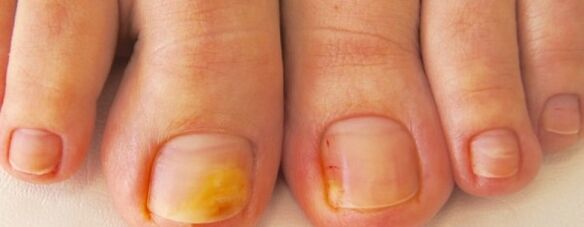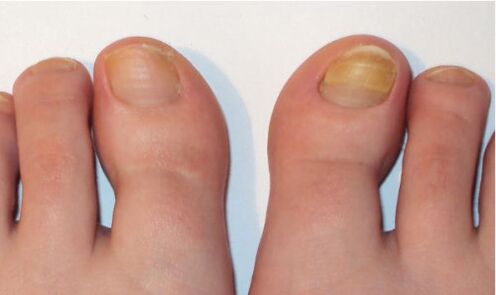Most people do not even know that the most common sweating of the feet and the unpleasant odor that accompanies it is one of the main signs of the development of a fungal disease. Toenail fungus, the symptoms of which do not appear immediately, can occur in any person who does not take at least a little care of himself. This disease awaits you almost everywhere and mostly in public places. What is sad is that a fungal disease is quite insidious: it is treated for a long period of time and in 100% of cases it is not effective, since it is characterized by relapses. In order to identify the fungus in time and start treatment, you need to have an idea of how toenail fungus manifests itself.

spread of a fungal disease
The disease is caused by the development of parasitic fungi in the body. The best conditions for their emergence and subsequent spread are a warm environment with high humidity at the same time. Many believe that it is very easy to catch such an infection in water parks, baths, beauty salons.
But the statistics are very different: even without leaving the house, you can contract a fungal infection through shared objects (bathroom, clothes, shoes, towels). However, this is true if at least one of the household members is a carrier of the fungus. But what basically influences the spread of the fungus? There are such key aspects that cause infection with a fungal disease:
- Heavy sweating;
- diabetes mellitus;
- The problem of being overweight;
- If the nail is injured;
- weak immunity.
In order to somehow protect yourself from infection with a fungus, you just need to use personal hygiene products, conduct a comprehensive treatment of the shower and bath, wear only your shoes, organize washing carpets as often as possible, etc. And if you already have the first onesIf you have noticed signs of toenail fungus, you should consult a dermatologist immediately!
Signs of a fungus, based on the causative agent of the disease

Signs of fungal infection on the toenails should be noticed in good time. The effectiveness of the complex treatment of a fungal infection is determined by the extent to which the causative agent of the disease has been correctly identified. This can be explained by the fact that there are many types of fungi, and each type responds to a specific group of drugs.
In most cases, the causative agents of the disease are:
- Mold;
- dermatophytes;
- Yeast.
If the fungus began to develop due to yeasts, it is almost impossible to detect the disease overnight. Signs of a fungus on the legs in such circumstances are as follows:
- The foot and the skin around the nail plate itching;
- The nail comes off.
Yeast infection occurs in only 4-5% of cases. Very often it is dermatophytes that attack the nail plate (94. 5%). This pathogen is of 3 types, and the manifestation of each is very different:
- 1 type. There is a simultaneous defeat of the nail plate, the skin of the feet and legs as a whole. Such a fungus easily moves to the nails and skin of the hands.
- 2 type. The disease affects only the nails of the thumb and little finger on the legs. Can also go into the creases between the fingers.
- 3 type. It is characterized by damage to the nail plate of the little finger and thumb, but the disease does not spread to the skin.
As with mold, the causative agent in this case is mold. It is observed extremely rarely. Mostly found in AIDS patients.
other symptoms

When the disease is just beginning to develop, there are often no symptoms of fungus on the toenails. But with extreme attention to the feet, a person will notice that round spots appeared on the nail plate, and the nail itself loses its shine and becomes rough. A developing fungal disease affects the nail plate more: at first its color changes, after which the nail peels off and can easily break. The shade of the nail plate is determined by the type of pathogenic fungus.
Toenail Fungus: Symptoms (Additional)
- The nail plate turns black;
- The nail takes on an unusual shape and its structure changes completely;
- nails become very brittle;
- nail plastic cuts under the skin;
- Followed by constant fatigue.
An abnormal appearance of the nail plate is a "bell" for a visit to a dermatologist, and there the nail fungus, the symptoms of which you have noticed, will be confirmed or denied. If you constantly postpone visiting the doctor, the disease will quickly spread to other areas. IfIf you do not think about it, this disease is not life-threatening. But, in addition to an exclusively aesthetic problem and discomfort, fungal infection is sometimes the cause of major complications. For this reason, the symptoms should not be ignored and treatment of the disease should be started in a timely manner as soon as they appearwas detected.
Doctor who treats fungal diseases
It is realistic to detect an infection yourself, but only a doctor can confirm your suspicions. To make an accurate diagnosis, a dermatologist will recommend certain tests. For their implementation, a piece of the destroyed nail plate or a scraping of the periungual tissue is taken.
An infection detected in time facilitates further treatment and excludes complications. If treatment is not started at the right time, it will ensure the spread of the disease to other organs and all the nails of the hands / feet.
Toenail fungus: treatment procedure
Therapy to treat the fungus is prescribed by a dermatologist - it all depends on how advanced the disease is, what kind of fungus is present in the body and other factors. When the fungus is just beginning to develop, drugs for external use are usually prescribed. In more difficult situations, you resort to intensive treatment.
By the way, that takes a lot of time. Therefore, it is in your interest to consult a doctor at the slightest suspicion of a fungal infection! Symptoms of nail fungus must be recognized in advance. And the earlier the disease is detected, the faster the treatment!































